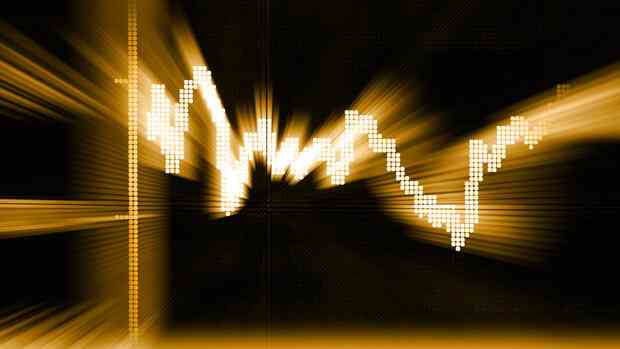In the afternoon, the Dax is 2.1 percent higher at 15,502 points, more than 300 points higher than at the close of trading the previous day. The leading index thus breaks through a sideways range that lies between 14,906 points on the lower and 15,270 points on the upper side. According to chart technology, a sustained breakout of this range should point the way for further development on the stock markets.
According to ECB President Christine Lagarde, the fight against high inflation is not over yet. The price pressure remains strong, she said on Thursday in Frankfurt. According to Lagarde, however, the risks of even higher inflation are no longer as pronounced. Recently, the situation has eased a bit because energy prices have fallen. Should this continue, the inflation rates could quickly fall again, but this is not certain. The aim of the ECB is therefore to limit inflation to two percent.
The central bankers also assume that the economy in the euro area will remain weak in the short term. However, they also warn that the economy as a whole has proved more resilient than expected and expect a recovery over the coming quarters.
No surprises in Fed decision
The Fed’s decision came as little surprise to investors: as expected, the central bank increased the interest rate by 25 basis points to the new range of 4.50 to 4.75 percent. US investors were briefly startled, the Dow Jones lost more than 300 points in the meantime, but then recovered again.
In a statement, the central bankers wrote that they considered “further interest rate hikes” to be “appropriate”, and at the press conference that followed, central bank chief Jerome Powell emphasized that the time for interest rate hikes was not over yet. We will remain on course until the work is done. The Fed’s job is to bring inflation to 2 percent, Powell said.
This is a trend reversal: so far, the Fed has raised its interest rates more than the ECB – that has changed today.
The decision was largely well received in Asia: in Tokyo, the Nikkei index rose 0.2 percent to 27,402 points on Thursday. The stock exchange in Shanghai, on the other hand, showed little change. The index of the most important companies in Shanghai and Shenzhen fell slightly. In South Korea, the index rose almost one percent.
The Bank of England has also announced its next interest rate move. As expected, the central bank is raising the key interest rate by half a percentage point to 4.0 percent. In view of the persistently high inflation of 10.5 percent recently, the monetary authorities are under pressure to act.
The central bank also signaled that the interest rate peak is approaching and that inflation has probably peaked. “This is clearly the last major hike from the Bank of England, we’re heading towards the end of this rate cycle in March or May,” said Ben Laidler, market strategist at brokerage eToro. The pound slipped after the decision was announced.
Company figures in focus
In addition to monetary policy, company figures will also be in focus on Thursday. Even before the start of trading in Frankfurt, some large companies presented their results.
Deutsche Bank was able to increase its profits by 159 percent to EUR 5.02 billion, significantly exceeding analyst expectations. It is the bank’s best result in 15 years. With a return on equity of 9.4 percent, the bank was also well above the target of eight percent it had set itself.
However, the bank only owes this return to a positive tax effect. Investors were disappointed by the figures. The stock fell 4.7 percent.
Things were not going so well for the Deutsche Bank subsidiary DWS: The consolidated result fell by 23 percent to 599 million euros. The reason for this was falling prices on the stock exchanges and the processing of the greenwashing allegations. The company promised a dividend of EUR 2.05 after EUR 2 in the previous year. The papers lose 4.1 percent.
The chip group Infineon also presented its figures in the morning: The Dax group continues to benefit from the energy transition and the trend towards electromobility.
Financial analyst Roth on market development: “We are approaching a decisive phase”
In the first fiscal quarter Infineon posted sales of EUR 3.95 billion and achieved an operating margin of 28 percent. Although sales fell by five percent compared to the previous quarter, profitability exceeded expert estimates.
At EUR 728 million, profit was around one percent below that of the previous quarter. For the year as a whole, Infineon expects sales of EUR 15.5 billion. The papers gain 7.3 percent.
euros and oil
One euro was little changed after the ECB’s decision lower at $1.0907. A barrel (159 liters) of North Sea Brent for delivery in April last cost $81.31, a barrel of American West Texas Intermediate (WTI) for March delivery was $75.03.
Look at other individual values
Hugo Boss: Jefferies analysts have downgraded the fashion group’s stock from “buy” to “hold”. The papers still gain 0.5 percent.
Sartorious: The papers of the Göttingen laboratory outfitter are among the strongest titles in the Dax. They are listed seven percent up at 446.90 euros.
Siemens Healthineers: The company posted a 30 percent drop in profits in the first quarter. The stock still gains 6.7 percent.
Vonovia: The housing group is also one of the strongest stocks in the Dax. The papers of the group gain around 7.4 percent.
Here you can go to the page with the Dax course, here you can find the current tops & flops in the Dax.
